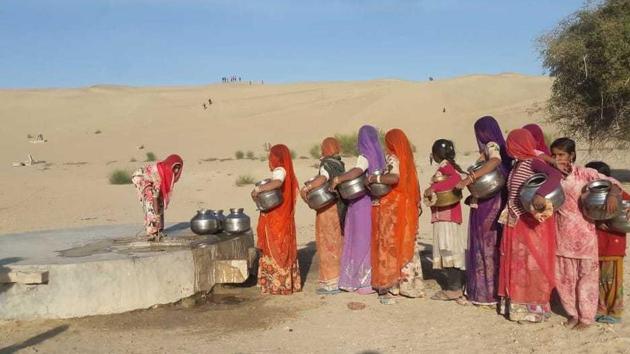Even in 3°C, women in Barmer region walk 3-5 km everyday for water
This is the fifth year in a row that Rajasthan’s Barmer area has received scanty rainfall with the district facing a drought-like situation.
In western Rajasthan’s Barmer, one thing remains constant and that is how people go about in their everyday lives even as temperatures change . That perpetual aspect of this water-starved region is its battle with the drinking water crisis all round the year.

So while the mercury is hovering between three and seven degrees Celsius these days, the locals’ struggle for drinking water is similar to what they experience in the summers. And lack of government assistance in helping the people deal with this crisis means they continue to travel in search of drinking water from three to five kilometers each day, every season.
Jethu Dan, a resident of Gordhaniyon Ki Dhani under Ramsar block, is 75-years-old and says he has heard politicians make promises and give assurances to deal with the crisis of drinking water throughout his life. “During my childhood, I saw my mother and other family members struggle for drinking water. I now see my wife and my daughters-in-law grind through the same task. Nothing has changed,” he said.
Resi Devi‘s village, Rohili, is located near sand dunes about 300 metres high from the ground level. Every day, she and other women have to walk down for the water. The routine does not change even when it as cold as 3°C and people do not want to step outside of their homes.
“With the first ray of the sun, we begin our walk down the sand dune to the water source. Anyone who misses the timeline stays without water for the day,” she said.
Devi explains that the people still depend on the traditional form of water bodies such as beri, a percolation well that harvests rainwater and is found in Rajasthan and Gujarat.
Chatur Singh Sodha, another villager, says traditional water bodies are the only source of water. “We have approached political leaders and government officials several times but to no avail. All we get is assurance. We feel it (battling the crisis) is our fate now,” he said.
For years, rainwater harvesting and storage structures like tankas, beris and others continued to be for all. Now, the crisis has forced many to keep the water in these structures under lock and key. Some even carry names to show the ownership.
The time ahead doesn’t appear to show improvement either.
Since September, when most parts of the state witnessed a deficit rainfall, residents bordering the Barmer district have been facing a severe drought situation. Local administration had sent the detailed crop assessment report to the state government in October, but it is still waiting for sanction for relief works.
This is the fifth year in a row that the area has received scanty rainfall with the district facing a drought-like situation. In 2014, some 1,600 villages were affected by drought, which came down to 1,470 the following year, only to jump up to 2,478 villages in 2016. While 1,900 villages were drought-hit in 2017, the figure reached to 2,694 in 2018.
The poor monsoon season has left the villagers facing a shortage of drinking water and fodder for the cattle.
In many villages, people have also started migrating to safer locations where drinking water and fodder for the cattle are easily available.
Despite this, authorities have barely woken up. The have ordered the crop assessment report on September 15 which was concluded on October 15.
According to the report, this time Barmer received 128mm rainfall as against the average of 275mm rainfall.
Crop assessment report revealed that 2,694 villages out of the total 2,775 villages are facing severe drought.
The situation is such that in 2,191 villages, crops in their entirety have been damaged while in the rest 503 villages 75 percent crops got damaged.
According to the report, the state agricultural department was expecting crop worth ~1,300 crore from the total 15 lakh hectares of cultivated area. But due to poor rainfall, crop worth ~1,200 crore have been damaged. The report further revealed that there is drinking water problem in 1,100 villages. In 200 villages, there is no source for drinking water that the government helped create. These villages depend on supply through water tankers, which is chargeable.






